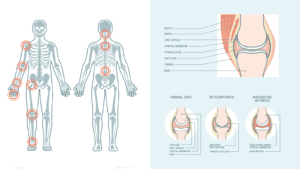Arthritis is a medical term physicians use to describe over 200 health conditions that cause pain and inflammation in the joints and the tissues around them. More surprising to many is that the foods we eat can impact the condition.
The most common form of arthritis is osteoarthritis. According to a study published by arthritis.org, it affects the lives of more than 30 million Americans. Osteoarthritis can cause pain and stiffness in any joint. However, it usually occurs in the feet, knees, hips, lower back, neck, or fingers.
Along with prescription and over-the-counter medication, tweaking your diet can help ease painful osteoarthritis symptoms. Also, the same advice applies to other forms of this degenerative joint disease, such as rheumatoid arthritis.
HOW DOES OSTEOARTHRITIS LEAD TO JOINT PAIN AND STIFFNESS?
Today we’ll detail some of the foods that can help ease pain and inflammation associated with osteoarthritis. First, let’s take a moment to familiarize ourselves with how the disease impacts the joints.
Osteoarthritis is the result of overuse. Thus, joints that people use frequently are the ones most likely to feel the impact of the condition. The most common occurrences arise in the following joints:
- Feet
- Knees
- Hips
- Lower back
- Neck
- Fingers
Osteoarthritis destroys the cartilage that normally cushions the bones in the joints in the body. This damage leads to bone-on-bone contact. The longer these bones rub against one another, the more damage they do to the muscles and connective tissues in the joints. Moreover, this series of events leads to severe stiffness, inflammation, and pain commonly associated with osteoarthritis.
WHO IS MOST AT RISK FOR DEVELOPING OSTEOARTHRITIS?
Unlike rheumatoid arthritis, which is an autoimmune disorder with an unknown etiology, osteoarthritis is far better understood. According to most physicians, scientists, and researchers, the following factors can significantly increase the risk of developing osteoarthritis:
Age – According to a study published by the CDC (Centers for Disease Control and Prevention), doctor-diagnosed arthritis, which includes osteoarthritis, is highest among individuals who are age 65 and over.
Gender – While there is no scientific data that clearly explains why there is a disparity, multiple studies have found that women are more likely than men to develop osteoarthritis.
Obesity– Not surprisingly, being overweight or obese can place a tremendous amount of strain on weight-bearing joints, causing them to become worn that much faster. That said, the more you weigh, the more likely you are to develop osteoarthritis that affects the knees, hips, and feet.
Genetics – For 35 to 65 percent of the U.S. population, osteoarthritis is caused by 1 of 9 genes that are associated with the disease, according to a study published by ScienceDaily, an online resource that provides information related to science, health, the environment, and technology.
It is also worth noting that joint injuries can cause osteoarthritis as well. To help substantiate this claim, we need only look to a study published by the National Institute of Health. The study revealed that 80 percent of American professional football players with a history of knee injuries showed signs of osteoarthritis. That said, it is entirely possible to develop osteoarthritis even at a young age.
FOODS THAT CAN HELP PREVENT OR EASE ARTHRITIS PAIN
Now that we have a better understanding of arthritis and who is most at risk for developing the condition, let’s take a moment to go over some of the foods that can help ease or possibly prevent arthritis pain:
1 -FATTY FISH
If you’re a fan of fish, you will be happy to know that adding sardines, salmon, mackerel, and other fatty fish to your diet can go a long way toward easing and possibly preventing arthritis pain. These fish are rich in omega-3 fatty acids, which are polyunsaturated fats with anti-inflammatory properties that can help alleviate the pain, stiffness, and inflammation synonymous with osteoarthritis. Further, these healthy fats have been shown to minimize the degradation of cartilage in the joints, which may reduce the chances of developing the disease in the first place. Along with fatty fish, flaxseed oil and certain nuts, such as almonds, macadamia nuts, and walnuts, are also excellent sources of omega-3 fatty acids as well.
2 – NON-FAT DAIRY
Adding more non-fat dairy foods like milk, cheese, and yogurt to your diet is yet another great way to combat the pain, inflammation, and stiffness associated with arthritis. Collectively, the protein, calcium, and vitamin D in these foods can help strengthen bones. And, it helps your body to build long, lean muscles to ease and potentially prevent arthritis pain. Also, opting for the non-fat variant can go a long way toward helping you maintain a healthy weight.
3 – OILS
Along with fatty fish and non-fat dairy, using extra virgin olive oil in place of vegetable or corn oil is also a great way to ease many of the symptoms synonymous with osteoarthritis. There is even evidence suggesting that this dietary change may also help to prevent the disease. Extra virgin olive oil contains oleocanthal, a natural phenolic compound that has many of the same properties found in popular over-the-counter anti-inflammatory medications, including ibuprofen. Also, according to the National Institute of Health, this same compound may offer protection against Alzheimer’s disease as well as certain cancers.
4 – LEAFY GREENS
Dark leafy greens like spinach, collard greens, and kale can strengthen the immune system as they are rich in vitamin D and antioxidants, both of which help ease osteoarthritis symptoms while making you less prone to illnesses and infections. It may also be a good idea to sprinkle a little bit of garlic over your vegetables as well. According to an article published by Medical News Today, garlic contains diallyl disulfide, a compound that has been shown to help combat the enzymes in the body that would otherwise target and destroy cartilage.
5 – GREEN TEA
While not technically a food per se, green tea contains polyphenols, plant-based compounds that offer various health benefits, as well as antioxidants that can fight off free radicals in the body. These ingredients have been shown to minimize the breakdown of cartilage and also relieve painful inflammation.
SPECIAL NOTE ABOUT RHEUMATOID ARTHRITIS:
While many of the foods listed in this article have been proven to help prevent arthritis; they may not be as effective in lowering the risk of developing rheumatoid arthritis as it is an autoimmune disorder, meaning it is not a byproduct of normal wear and tear of cartilage as in the case of osteoarthritis. Nonetheless, these foods can help ease pain, stiffness, and inflammation brought on by this form of arthritis as well.
FOODS THAT YOU SHOULD AVOID TO DECREASE ARTHRITIS PAIN
Along with the food that can help ease and possibly prevent osteoarthritis, there are some that you will want to avoid as they can trigger or intensify arthritis pain:
1 – GRANULATED SUGAR
Granulated sugar triggers the release of cytokines, small proteins that play a critical role in cell signaling in the body. Thus, food and drinks that contain a lot of granulated sugar may prove to intensify inflammation.
2 – SATURATED FAT
Those who have osteoarthritis or are at risk of developing the disease should avoid eating food that is high in saturated fat, such as red meat, dark chicken, and high-fat dairy products, for example. A diet rich in saturated fats can lead to obesity and also trigger inflammation in fat tissue. Of course, both conditions can cause osteoarthritis. And for those who already have the disease, it can make matters even worse by intensifying pain and other symptoms.
3 – SIMPLE CARBOHYDRATES
Similar to granulated sugar and saturated fat, a diet high in simple carbohydrates can also trigger or worsen arthritis pain. That’s because they contain advanced glycation end oxidants, harmful compounds that can cause numerous health problems, including inflammation. Simple carbohydrates consist of the following type of foods:
- Potato chips
- White bread
- White pasta
- Candies
- Sodas
- White flour
If you have the option, it is always best to choose whole-grain carbohydrates as they offer more nutritional value. And, they can improve your health by contributing to the following:
- Helps regulate and stabilize blood glucose levels
- Help regulate appetite
- Better digestive health
 FINAL THOUGHTS ON THE LINK BETWEEN ARTHRITIS AND THE FOODS YOU CONSUME
FINAL THOUGHTS ON THE LINK BETWEEN ARTHRITIS AND THE FOODS YOU CONSUME
If you’re struggling with arthritis pain caused by osteoarthritis, make small changes to your diet. New eating habits can go a long way toward reducing your chances of suffering pain or provide some much-needed relief.
Of course, these changes won’t prevent rheumatoid arthritis. However, they are still worth implementing. That’s because a healthy diet can help ease the pain and inflammation associated with this form of arthritis.














 Community
Community

